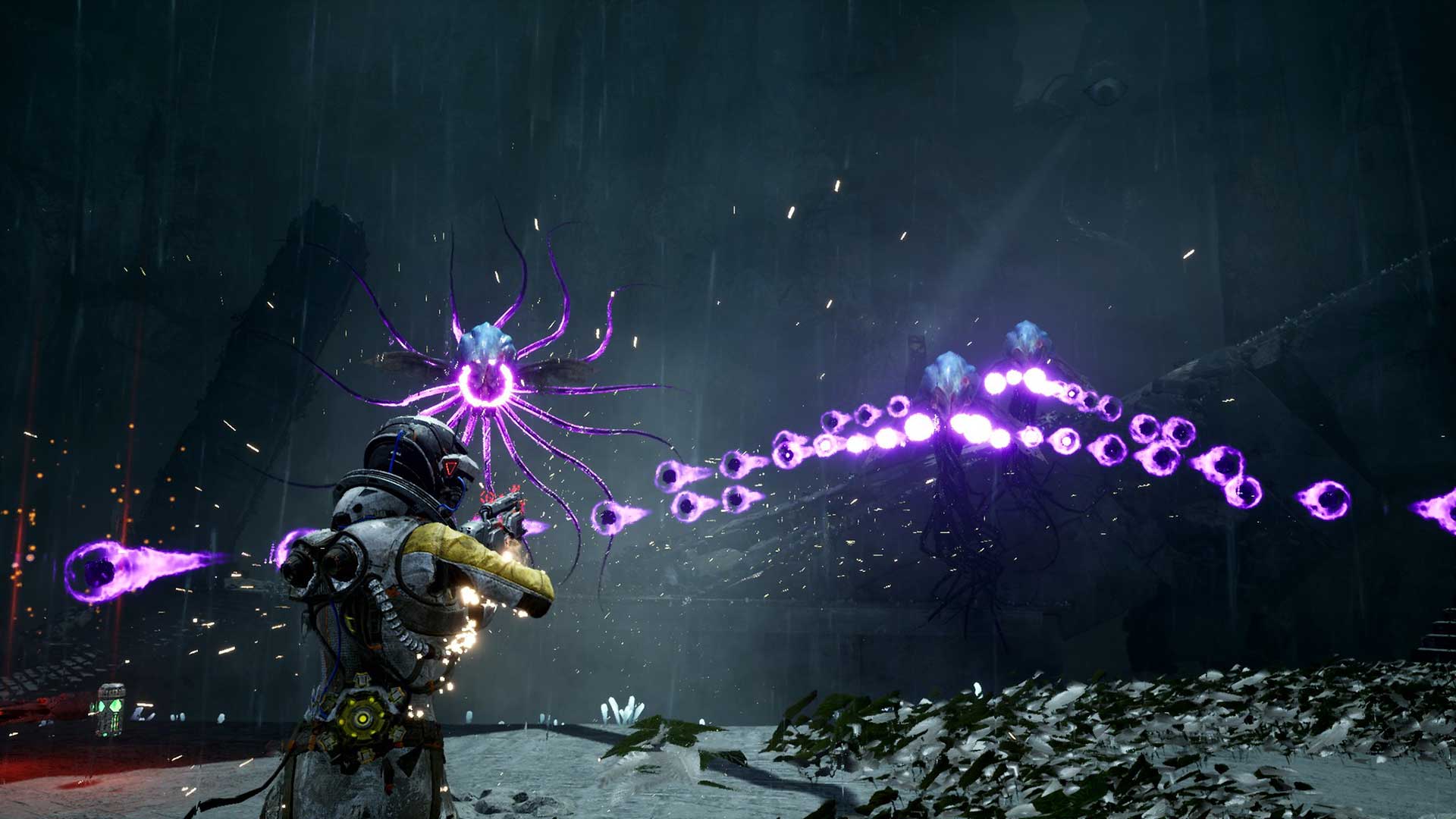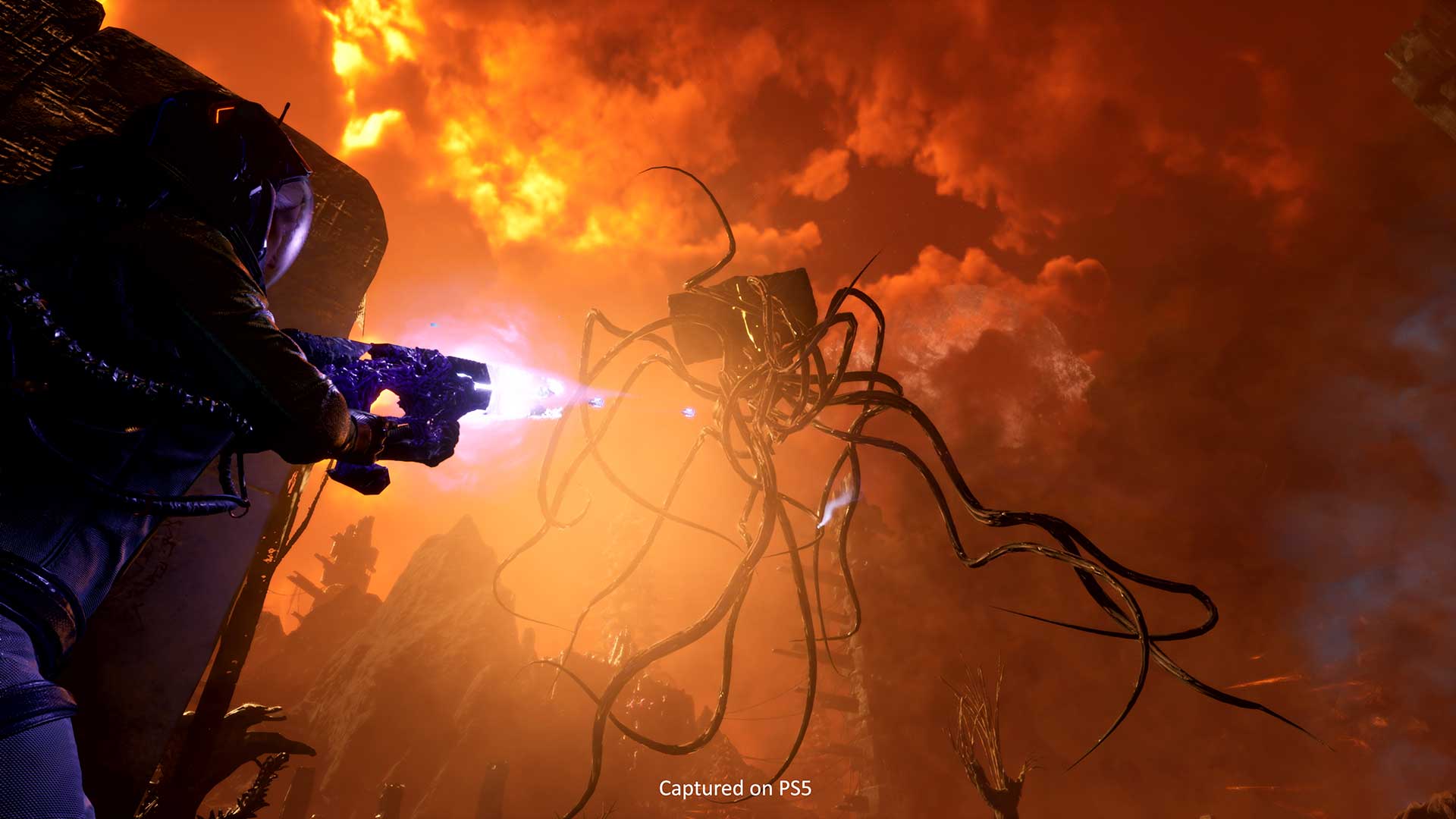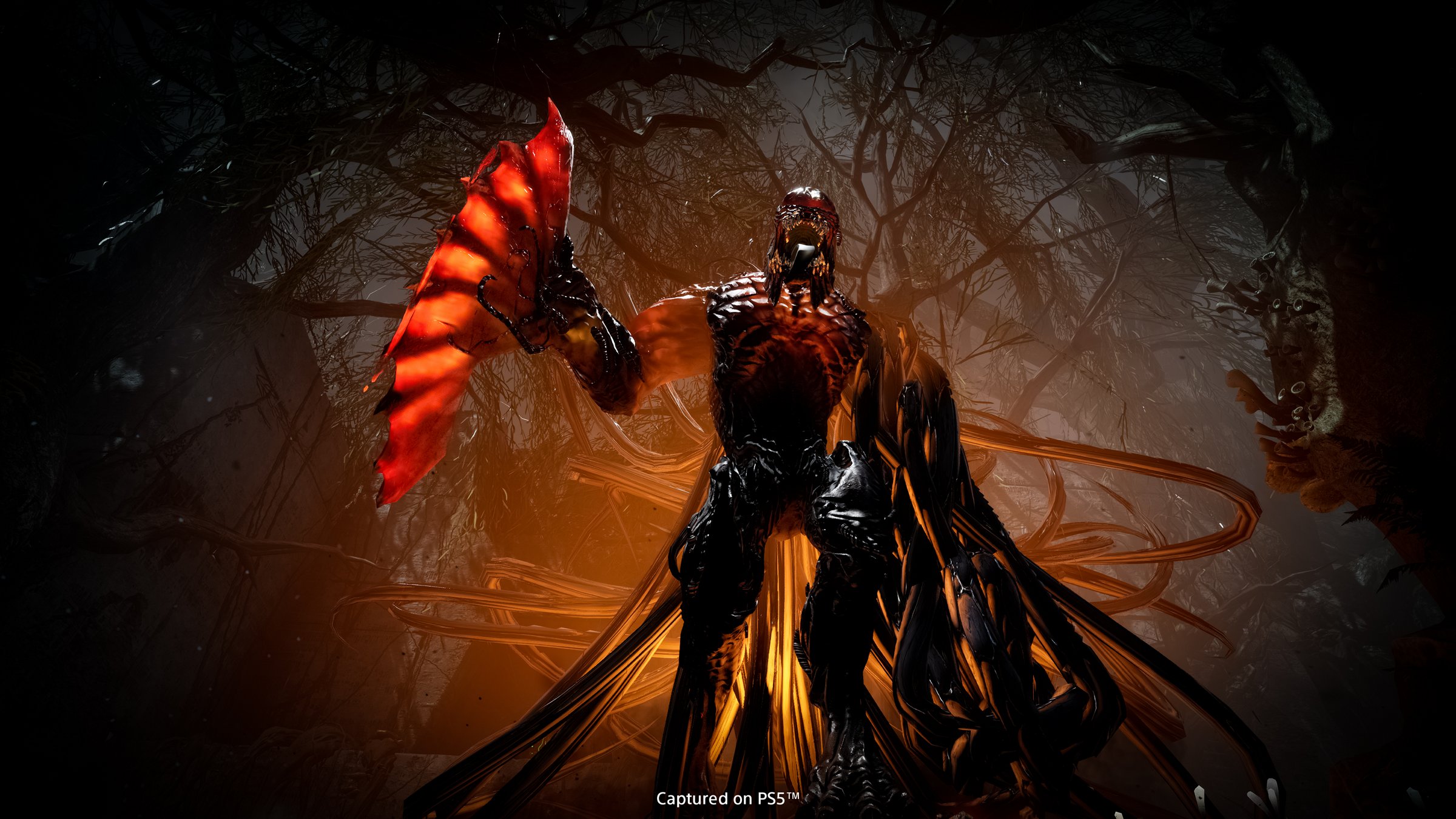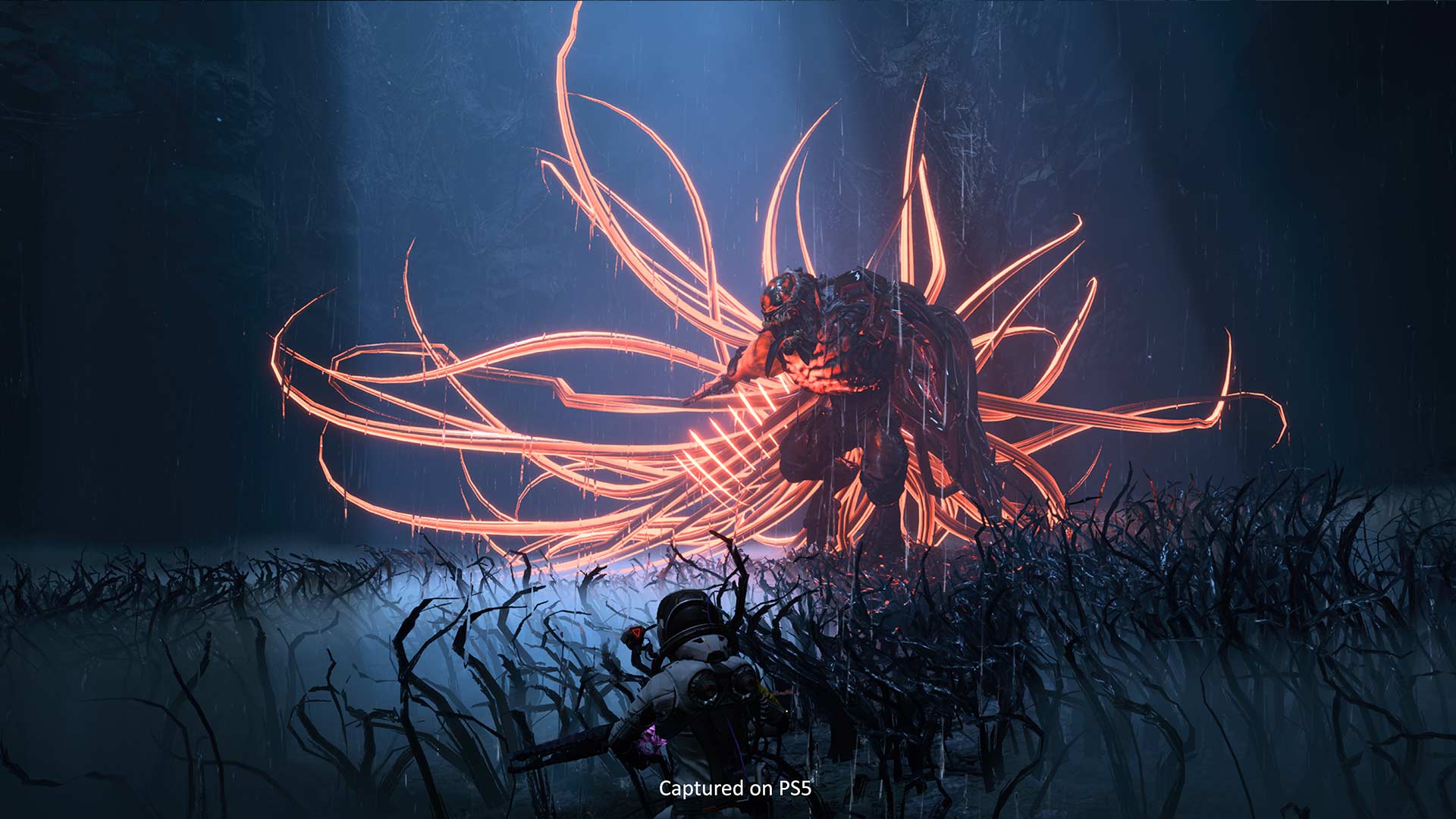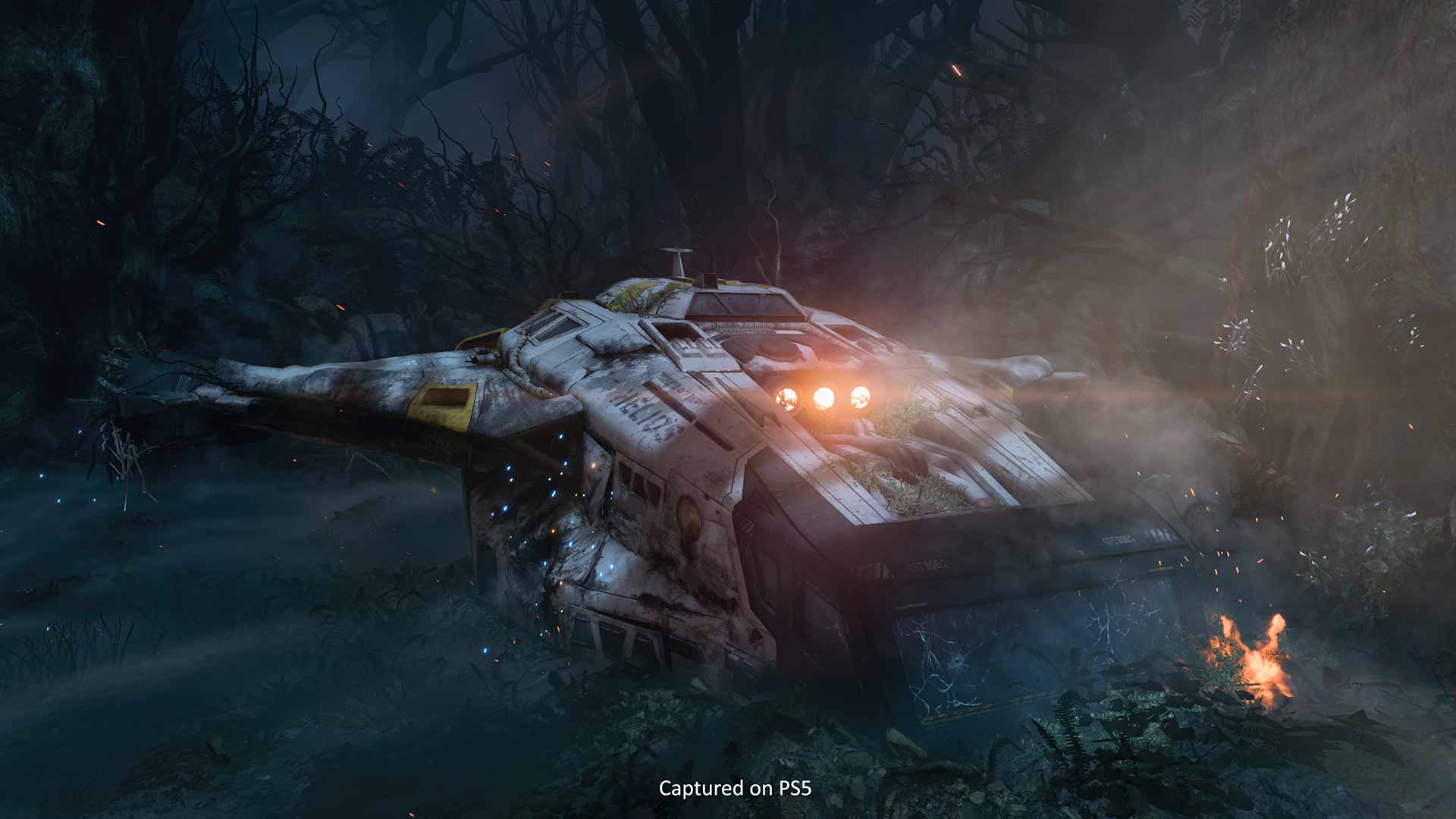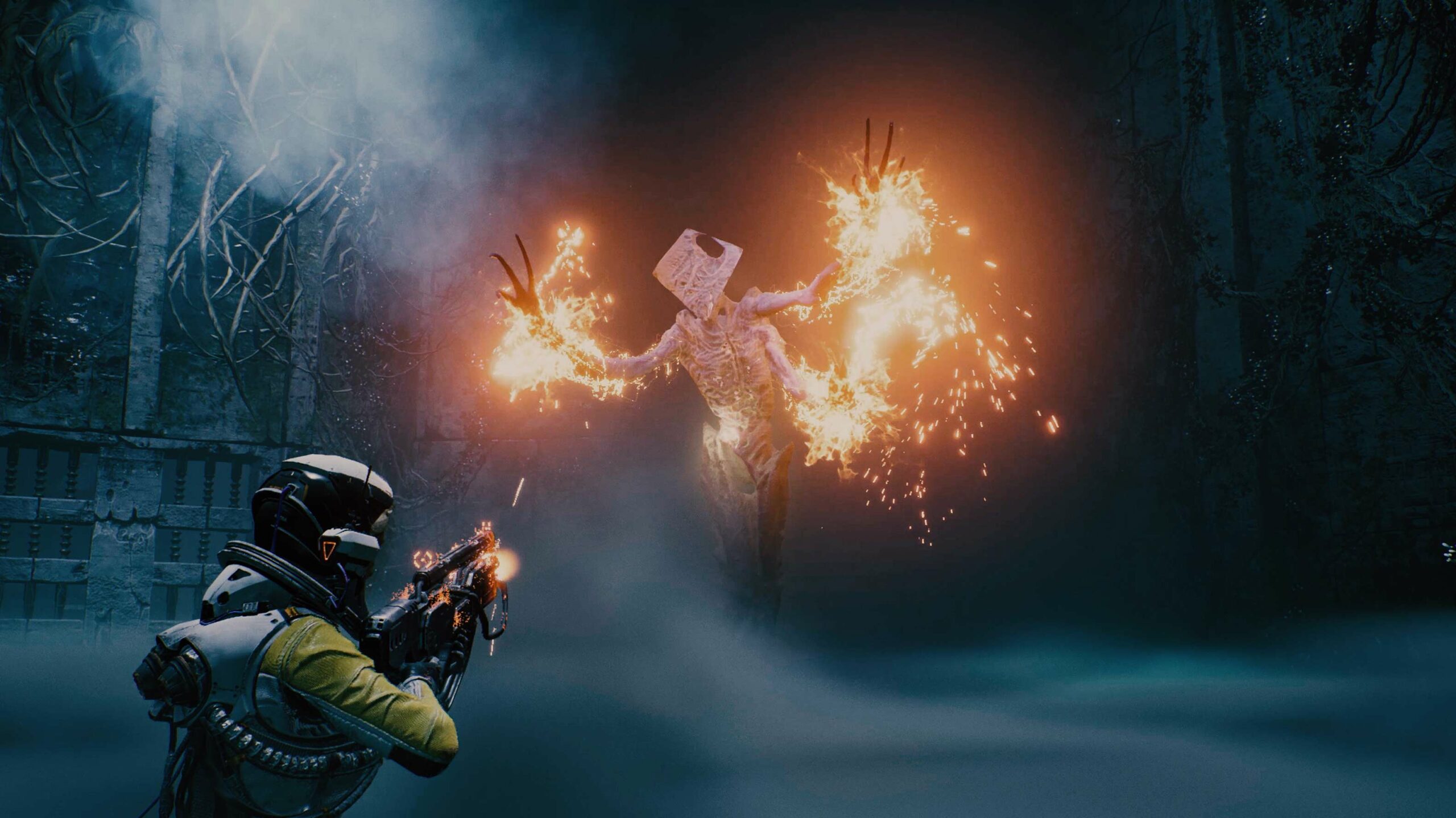
For nearly 15 years, one of the PlayStation brand’s most consistent and prolific developers has been Housemarque.
Starting with 2007’s Super Stardust HD, the independent Finnish studio has released such acclaimed PlayStation arcade titles as Dead Nation on the PS3 and Resogun, Alienation and Next Machina on the PS4, garnering a dedicated fanbase.
Now, Housemarque is poised to release its most ambitious and radically different title to date: Returnal. However, in a departure from the shoot ’em up-style games the developer is best known for, Returnal is a third-person shooter with roguelike elements.
In other words, players will be dying often as they explore a procedurally generated alien world as space pilot Selene. All the while, Returnal‘s status as one of the few PlayStation 5 exclusives to date means it serves as an impressive showcase of the console’s technical capabilities.
With all of that in mind, MobileSyrup sat down with game director Harry Krueger and narrative director Gregory Louden to get a better idea of what to expect from this intriguing PS5 title.
Question: Housemarque has a lineage of arcade-style games, but in 2017, the studio emphatically declared ‘arcade is dead’ as you shifted towards a new style of games. How, then, did you ultimately decide on pursuing this particular type of game with Returnal and what were some of the challenges in doing that?
Harry Krueger: I think that statement of ‘arcade is dead’ was more just a commentary on the sign of the times. Maybe just the business model of making relatively small games with relatively big budgets, one could say. From a creative standpoint, when I hear ‘arcade is dead,’ I can proudly say ‘long live the arcade.’ And I can say that, yes, we have built a heritage of these arcade-inspired experiences during the last two console generations.
We feel like Returnal is, in many ways, a natural continuation of that creative philosophy. So we are taking all of those sensibilities of arcade-inspired games and really just cranking them up to 13 and taking them to the next level with the PS5 and with Returnal.
Q: To that point, Returnal is one of the few wholly PS5 exclusives we’ve seen so far, in that it’s not on PS4 as well. By focusing on the PS5, what were you able to achieve from a technical perspective? How did that empower your vision for the game?
Krueger: Yeah, keeping our eyes on the prize on the next generation, so to speak, is always very liberating. When you’re doing multi-platform development, the weakest platform always becomes the lead platform in a way. And we’ve been fortunate, with the PS5 and Returnal, to be focusing exclusively on maximizing the potential of this new hardware. So aside from the obvious increase in processing power — which has allowed us to really push the fidelity and the flair of a lot of our particle effects that we’re known for and just really bring that richness to the experience — there’s a lot of very specific hardware possibilities that have become possible with the DualSense controller.
“Being able to pinpoint where an enemy just spawned, or where a bullet pattern just spawned, really helps with that second-to-second immersion of the gameplay”
For example, we have haptics that are an entirely new dimension of nuanced expression, in terms of haptic feedback. We [also] have the adaptive triggers that we’re using for the core gameplay. So if you press L2 halfway down, you get the aiming down sights, or the normal focus aim, and beyond that, it actually clicks into place, and switches to alt-fire mode. And that’s a new way to play these kinds of games, I feel. And it’s very intuitive — it’s really just pick up and play.
Another area here is 3D audio. So aside from adding, of course, the richness to a lot of our narrative segments where you can really appreciate these more nuanced layers of expression there, we also, even in the hectic combat moments, have bullet hell, enemies firing left and right, where the 3D audio actually helps a lot with your spatial awareness, and just the positionality of different threats. Being able to pinpoint where an enemy just spawned, or where a bullet pattern just spawned, really helps with that second-to-second immersion of the gameplay.
Q: You talked about the shooting, and based on the gameplay footage released so far, the guns look quite varied and flashy. How many different types of weapons are there and how do they evolve over time as you go through subsequent runs?
Krueger: So there are multiple layers here. We have 10 different weapon types. We have the more familiar archetypes that we know and love from third- and first-person games. But we are experimenting with a lot more wild and crazy kinds of alien technology, biotechnology, and also some cosmic-inspired weapons. So these are just the basic behaviours, but there are layers of modifiers that we’re calling traits that you can unlock for these as you play more.
These are modifiers that are permanently unlocked to the pool of modifiers in the game. So you will need to earn these the first run by killing enemies by using that weapon. So the more you familiarize yourself with a weapon, the more of its potential you unlock. But once you have unlocked these, you can find that same weapon in the next run, at a much earlier stage with these modifiers attached to it.
These modifiers can be all kinds of different things; you can have a shotgun that has a modifier that turns it more into a Railgun kind of weapon, so a more focused, single, precise blast. You can have explosive rounds, piercing rounds — all of these can stack as well. So this leads to hundreds of different combinations of different weapons, each with its own strengths and weaknesses and strategic playstyles.
That’s just one of the many elements that tie to our permanent progression. There are [also] different types of artifacts, weapons, parasites, ‘malignant items,’ and lots of different kinds of upgrades that you can collect that are permanently added to the pool and allow you to enrich your future sessions as well. The more you play Returnal, the more it opens up to you.
There are some notes about permanent progression I’d like to make as well. Yes, in a traditional roguelike manner, players will lose a lot of their in-session progress, and they will need to start again from the crash landing location and earn that progress again. However, there are certain upgrades, abilities and items that will persist across runs, such as a melee upgrade, a hook shot and a key that opens a specific type of door. These will persist across multiple runs, allowing you to gain more access to previously accessible areas, more traversal and combat options.
Q: I know you don’t want to give too much away, but a lot about the story of the game has been kept under wraps. What can you tell me about Selene and her mission — what’s driving her in the game?
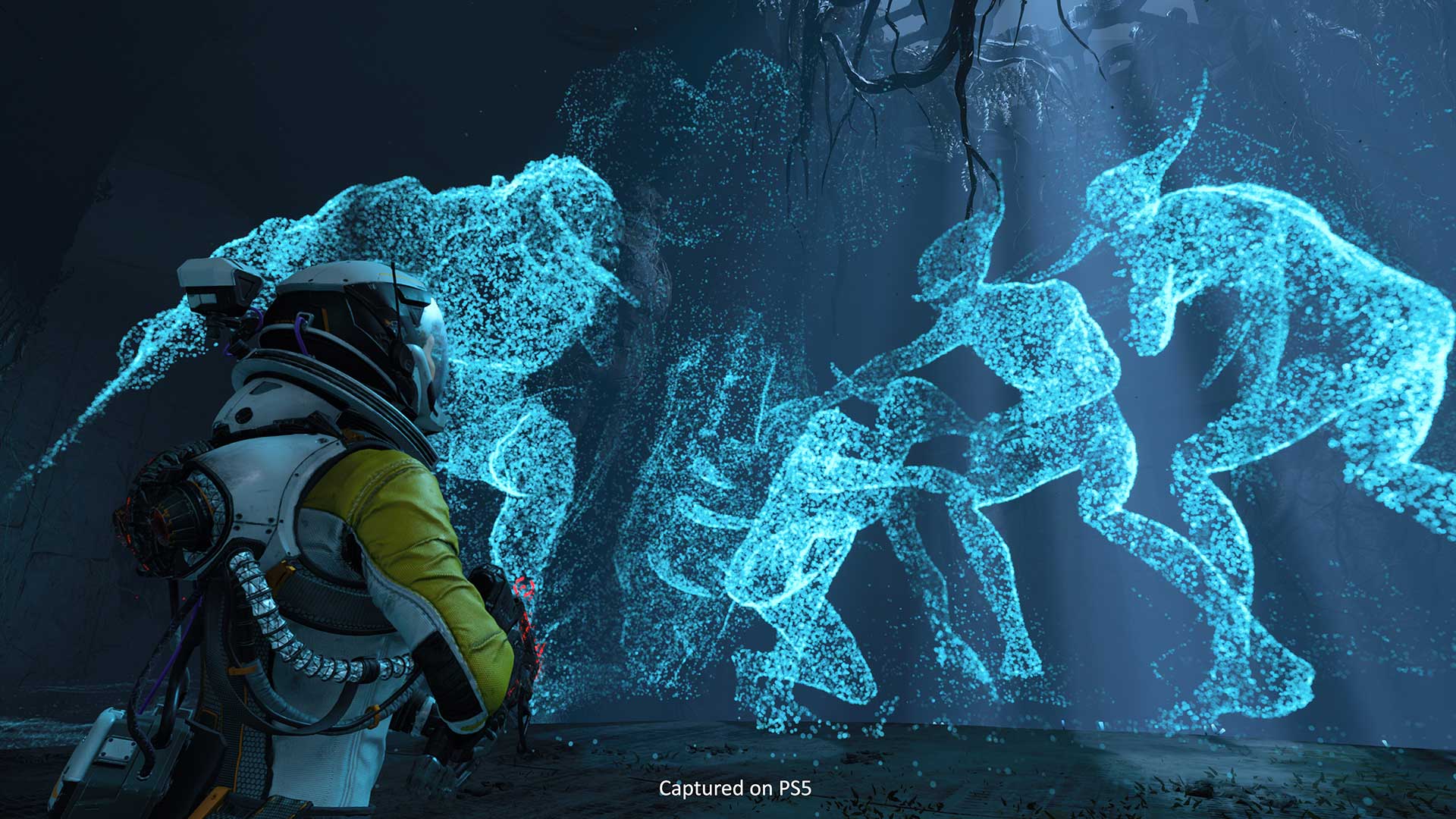 Krueger: There’s a lot of different themes that we were inspired from to craft Returnal as a concept. Of course, we have dark sci-fi, cosmic horror and psychological horror themes that we wanted to explore. A time loop with an ever-changing planet [as well]. All of these things were solidified very early on in the vision of the game. And we knew that we wanted to tell the story through the roguelike nature of the game, and also have a multi-dimensional and complex character at the centre of it.
Krueger: There’s a lot of different themes that we were inspired from to craft Returnal as a concept. Of course, we have dark sci-fi, cosmic horror and psychological horror themes that we wanted to explore. A time loop with an ever-changing planet [as well]. All of these things were solidified very early on in the vision of the game. And we knew that we wanted to tell the story through the roguelike nature of the game, and also have a multi-dimensional and complex character at the centre of it.
And there are some themes here that we have explored; for example, there’s the call of the void, that very early on, you see Selene — against her better judgment, perhaps — answering this mysterious signal that someone’s heard to this alien planet called Atropos, where she quickly finds herself succumbing to the elements, and then being trapped in this nightmarish cycle where even death is no escape.
Gregory Louden: With the narrative, it’s been really exciting because this is how we can define what Housemarque storytelling is. And for us, it’s been about wanting to do a new type of story. With that in mind, we knew we needed to create a story that could survive the repetition of the roguelike. We wanted to create a mysterious and haunting story that is very layered. That way, when you see something at the start of the game, it can survive the repetition, so the recontextualization of that, by the end, makes it really impactful.
a story that could survive the repetition of the roguelike. We wanted to create a mysterious and haunting story that is very layered. That way, when you see something at the start of the game, it can survive the repetition, so the recontextualization of that, by the end, makes it really impactful.
“With Returnal, we wanted to create a story that asks you a lot of questions”
So we wanted to create this layered story that every time you cycle, every time you die and come back and see the world shuffle in front of you, you can get new insight into the story. So I do recommend players really examine and listen in and look at the world-building and the art, listen to the sound design and question things, because Atropos is a character in Returnal, and Seline and Atropos are kind of interlinked in more ways than what you first think when you play the game.
I would like to say about Selene, as well, that she is a Greek-American Astro Deep Space scout. She’s highly capable, highly trained, she’s driven to a fault. And, as Harry alluded to, she’s there to pursue this mysterious signal white shadow, which is almost like a spell that compels her to come to Atropos, despite her better judgment. And then when she is there, another thing that is really adding to the dilemma of her and also adding to our storytelling, she actually discovers other versions of herself that have been through the cycle. And some of these actually have audio logs that you can listen to. And when you do, you can listen to Selene from future cycles, and from the past, which provides this non-linear narrative and once again, goes into this mysterious and haunting nature. It’s a story that you just need to keep piecing together and keep trying to understand.
With Returnal, we wanted to create a story that asks you a lot of questions, and, as I said, is mysterious and haunting. So in that sense, after you’ve finished the game, ideally, you’re left with questions, and you’re left with wanting to replay the game, re-examine the audio logs, re-listen to things that you discover, look into the story of the alien civilization, and really try to decipher the mystery of what Returnal is. It’s been a really exciting project to be a part of, and really great to establish how Housemarque tells stories as well.
Q: Some of the more narrative-heavy sequences seem to come in these first-person house sections you’ve teased, which almost give off Resident Evil VII or P.T. vibes. Can you elaborate on these sections? What was the design philosophy behind them and how often might they occur to shake up the moment-to-moment gameplay?
Louden: For us, with the house sequences, what better way to get to know a character than to be in their shoes? To literally be in Selene’s spacesuit and see her past and see this mysterious house from her perspective. It was all about providing a much higher sense of intimacy, and actually changing the atmosphere, changing the vibe, and allowing you to explore this house.
We put a lot of attention to detail into the environment there, and the environmental storytelling, and also into the sound design and made full use of the 3D audio. You can feel things with the DualSense sense, you can feel the texture, and you can feel the elements as she’s exploring through the house.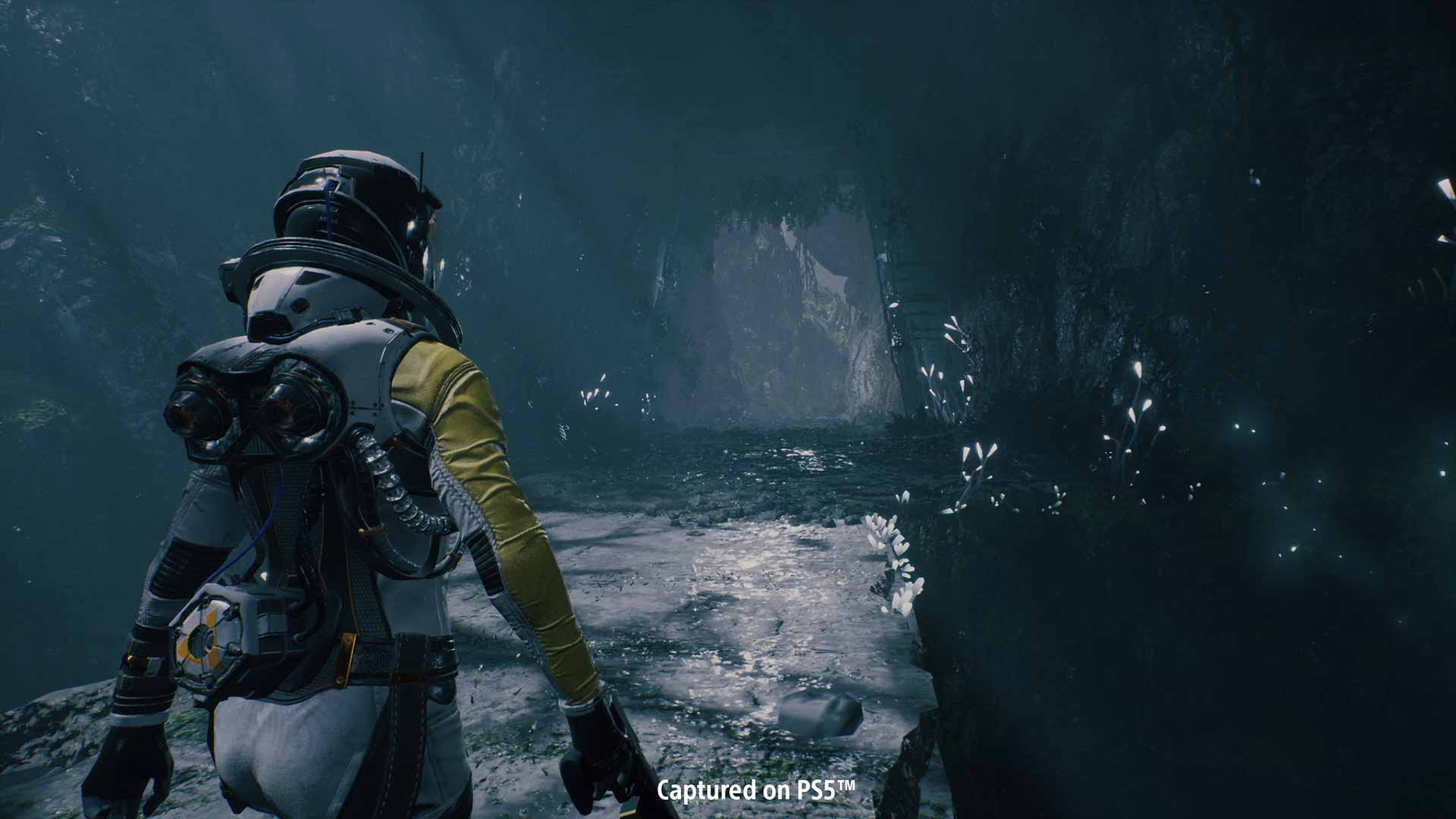
It was all about taking you into her perspective, taking you into her intimate place, her house, and exploring that idea that I raised earlier, that Atropos and Selene and the planet are beginning to reflect each other. And the planet knows her more intimately than it should. It begins to show her these images and other things that she can go through.
In terms of how often do you see these houses, there are more houses than what you just saw. Generally, you can find them as you progress through the story, and as you progress, they provide more insight and more mystery, and other layers for you to explore. I’m personally very excited about them, because we really explore some really interesting elements.
Q: You mentioned that Atropos is its own character. Since the world is changing on every run, how much variety can we expect in terms of different kinds of environments?
Kruger: So we have tried to create very rich biodiversity with our different environments. I wouldn’t want to give an exact number for you because there are a lot of story elements and surprises that we have in store for players that we’re really looking forward to seeing how they react when they stumble upon these. But suffice to say that every biome does have its own unique personality, its own unique flavor of world-building, its own narrative context, as well as its significance in the story — both in a literal and symbolic sense.
And from a gameplay perspective, there is, of course, a strong emphasis on the roguelike procedural generation, so lots of content in each biome. Unique enemy encounters, unique environmental hazards, unique flavours of bullet hell patterns, beam hazards — these kinds of things will give each biome that unique identity.
“So even if you do familiarize yourself with a particular area — or a particular treasure room, for instance — it might often be populated with unfamiliar content…”
And, of course, [there are] unique loot and unique secrets, unique rewards to discover in each one. And last but not least, I should mention that there’s also, unsurprisingly, a boss waiting at the end of these biomes to give you that climactic combat moment where we just bring out all of the tricks and gameplay elements that we have briefly introduced up until that point.
Q: I also noticed during the demo you showed that there are different types of rooms, such as a combat-free one focused on light traversal. What are some of the other ways that you’re shaking up room configurations?
Krueger: So each biome has its own pool of content that we’re drawing from. In terms of procedural generation, we’re using a bit of a hybrid approach. So we do want to have that handcrafted feeling of quality to our areas, our narrative spaces, our treasure rooms, our platforming segments. We have these collections of areas that are handcrafted, and then they are combined and configured very freely each time a new generation is triggered. These are also populated differently as well.
So even if you do familiarize yourself with a particular area — or a particular treasure room, for instance — it might often be populated with unfamiliar content, and maybe even some threats sometimes as well. These are just some quick examples of the many ways we’re trying to make each run feel unique, and, ideally, create memorable player stories each time you play Returnal.
This interview has been edited for language and clarity.
Returnal releases exclusively on the PlayStation 5 on April 30th, 2021.
Image credit: PlayStation
MobileSyrup may earn a commission from purchases made via our links, which helps fund the journalism we provide free on our website. These links do not influence our editorial content. Support us here.

